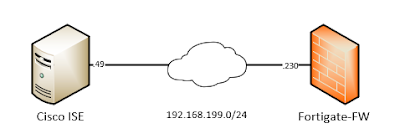Now we will configure our routers.
Assign IP address to the physical interface.
interface GigabitEthernet0/7
ip address 192.168.10.1 255.255.255.0
!
interface GigabitEthernet0/0
ip address 172.16.51.1 255.255.255.0
Create the phase-1 policy.
crypto isakmp policy 10
authentication pre-share
encr aes --Encryption algorithm
hash sha256 --Authentication algorithm
group 14 --DH group
lifetime 80000 --Key lifetime
Configure the pre-shared key for the IPSec peer.
crypto isakmp key test123 address 172.16.51.2 --Pre-shared key for the peer
Configure phase-2 policy/transform-set.
crypto ipsec transform-set Transform-Site-B esp-aes esp-sha256-hmac
mode tunnel --Phase-2 uses encryption AES and authentication SHA256
Instead of using crypto-map, we will create a IPSec profile and associate the transform-set with it.
crypto ipsec profile Profile-Site-B
set transform-set Transform-Site-B --Associating transform-set with profile
set pfs group14 --Uses PFS with DH group 14
set security-association lifetime seconds 70000 --Key lifetime
Now we will create the tunnel interface. Important thing here is that the tunnel must have an IP address, we can assign an IP address to it or borrow an IP address from another interface using "ip unnumbered" command. Otherwise our static route for selecting which traffic will be encrypted will not come into the routing table.
interface Tunnel0
description IPSec-Tunnel-To-Site-B
tunnel mode ipsec ipv4 --Tunnel is ipsec encrypted, carries IPv4 payload
tunnel protection ipsec profile Profile-Site-B --IPSec profile association
tunnel source 172.16.51.1
tunnel destination 172.16.51.2
ip unnumbered GigabitEthernet0/0 --Borrowing an IP adress from GE0/0
Now we will select which traffic will be encrypted by means of creating a static route which has tunnel interface as outgoing interface.
ip route 192.168.20.0 255.255.255.0 Tunnel0
For Site-B-Rtr, the configuration is exactly same, just the IP addresses will be changed. Below is the full configuration from Site-B-Rtr -
interface GigabitEthernet0/7
ip address 192.168.20.1 255.255.255.0
!
interface GigabitEthernet0/0
ip address 172.16.51.2 255.255.255.0
!
crypto isakmp policy 10
authentication pre-share
encr aes
hash sha256
group 14
lifetime 80000
!
crypto isakmp key test123 address 172.16.51.1
!
crypto ipsec transform-set Transform-Site-A esp-aes esp-sha256-hmac
mode tunnel
!
crypto ipsec profile Profile-Site-A
set transform-set Transform-Site-A
set pfs group14
set security-association lifetime seconds 70000
!
interface Tunnel0
description IPSec-Tunnel-To-Site-A
tunnel mode ipsec ipv4
tunnel protection ipsec profile Profile-Site-A
tunnel source 172.16.51.1
tunnel destination 172.16.51.2
ip unnumbered GigabitEthernet0/0
!
ip route 192.168.20.0 255.255.255.0 Tunnel0
!
Verification
Let's start our verification -
We will send a simple ping command from Site-A-PC (192.168.10.2) to Site-B-PC (192.168.20.2).
S-A-PC> ping 192.168.20.2
84 bytes from 192.168.20.2 icmp_seq=1 ttl=62 time=4.521 ms
84 bytes from 192.168.20.2 icmp_seq=2 ttl=62 time=4.451 ms
84 bytes from 192.168.20.2 icmp_seq=3 ttl=62 time=4.427 ms
We can see that our ping is going through. Now we will find out why the ping is going through. We will run some diagnostic command from Site-A-Rtr -
Site-A-Rtr#show ip interface brief
Interface IP-Address OK? Method Status Protocol
GigabitEthernet0/0 172.16.51.1 YES manual up up
GigabitEthernet0/7 192.168.10.1 YES manual up up
Tunnel0 172.16.51.1 YES TFTP up up
We can see that our tunnel interface is "UP" and it is using GE0/0's IP address because of the "ip unnumbered" command.
Site-A-Rtr#show ip route
Gateway of last resort is not set
172.16.0.0/16 is variably subnetted, 2 subnets, 2 masks
C 172.16.51.0/24 is directly connected, GigabitEthernet0/0
L 172.16.51.1/32 is directly connected, GigabitEthernet0/0
192.168.10.0/24 is variably subnetted, 2 subnets, 2 masks
C 192.168.10.0/24 is directly connected, GigabitEthernet0/7
L 192.168.10.1/32 is directly connected, GigabitEthernet0/7
S 192.168.20.0/24 is directly connected, Tunnel0
Our static route to Site-B network (192.168.20.0/24) is also in the routing table.
With below commands we can also verify that traffic is encrypted and using proper phase-1 and phase-2 parameters (authentication, encryption, DH group, PFS etc.)
Site-A-Rtr#show crypto isakmp sa detail
Codes: C - IKE configuration mode, D - Dead Peer Detection
K - Keepalives, N - NAT-traversal
T - cTCP encapsulation, X - IKE Extended Authentication
psk - Preshared key, rsig - RSA signature
renc - RSA encryption
IPv4 Crypto ISAKMP SA
C-id Local Remote Status Encr Hash Auth DH
1001 172.16.51.1 172.16.51.2 ACTIVE aes sha256 psk 14
Site-A-Rtr#show crypto ipsec sa detail
local crypto endpt.: 172.16.51.1, remote crypto endpt.: 172.16.51.2
plaintext mtu 1422, path mtu 1500, ip mtu 1500, ip mtu idb GigabitEthernet0/0
current outbound spi: 0xF240396C(4064295276)
PFS (Y/N): Y, DH group: group14
inbound esp sas:
spi: 0x70695424(1885951012)
transform: esp-aes ,
in use settings ={Tunnel, }
conn id: 7, flow_id: SW:7, sibling_flags 80004070, crypto map: Tunnel0-head-0
sa timing: remaining key lifetime (k/sec): (4282358/69852)
IV size: 16 bytes
replay detection support: Y
Status: ACTIVE(ACTIVE)
inbound ah sas:
spi: 0x6ED23B7A(1859271546)
transform: ah-sha256-hmac ,
in use settings ={Tunnel, }
conn id: 7, flow_id: SW:7, sibling_flags 80004070, crypto map: Tunnel0-head-0
sa timing: remaining key lifetime (k/sec): (4282358/69852)
replay detection support: Y
Status: ACTIVE(ACTIVE)
So, above example is called IPSec tunnel mode where we have a IPSec encapsulated tunnel interface and the routing is done over that interface.




Comments
Post a Comment